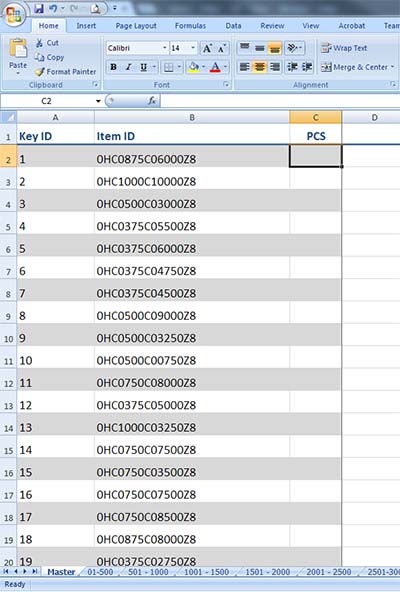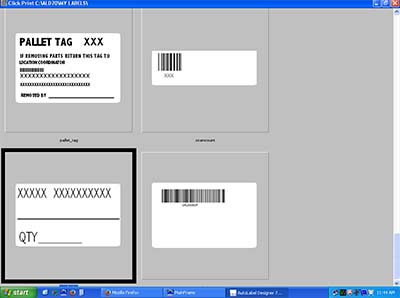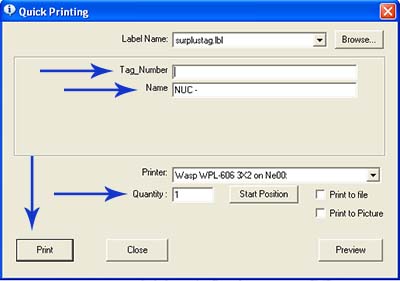| Who is Who? |
Who needs to be involved in processing surplus? You may or may not need several people involved in processing a surplus. In some cases the same person could perform multiple functions. This tutorial begins with the assumption the product has already been unloaded and stored.
- A controller. The controller will maintain a simple spreadsheet, create the tags, and reconcile the tags. View “The controller” for more info.
- Package coordinator to make labels from the information provided on the tag. View “The Package Coordinator” for more info.
- A packager to package or repackage the parts. View “The Packager” for more info.
- A stock person to stock the parts. View “The Stock Person” for more info.
- Someone to make new part numbers if needed.
- Receiving clerk to receive the parts into the computer.
| The controller |
What are you going to call the surplus? You need to do is decide what the name or code for the surplus will be. This code should be letters of the alphabet rather than numerical but if necessary it can be numbers. Below are some examples of codes that have been used in the past.
- Fastener World = FSTWLD
- Nucor = NUC
- 1108 = 1108
How much surplus do you have? You need to know an approximate number of different items. This does not have to be an exact number it is just a number you come up with so you will know how many tags you will need to print. You can always print more tags later if you need to. The tags Either you or the package coordinator can print the tags. Each tag number should have a duplicate. See the package coordinator section on how to print the tags. Once the tags are printed you are responsible for identifying the product (you can assign the identifying process to someone else) and recording either the description or the part number on the tags. You will need to hand write the information on the master tag and the tag that will stay with the parts. You will use the master tag to record the necessary information on the spreadsheet and the duplicate tag will be returned to you at a later date by the package coordinator for you to reconcile the parts in the spreadsheet and mate with the original tag. You need to inform the package coordinator how often you want the tags to be returned to you. Once the tag that remained with the parts is returned to you enter the information in the spreadsheet and arrange the tags neatly in numerical order. You should also take this opportunity to view the label on the back that was placed there by the packager to ensure the label was made correctly. Do not throw either tag away. You will need to save both tags in order to resolve a potential question that may arise at a later date. The spreadsheet 
The spreadsheet should consist of three columns.
Key ID = This is the tag ID
Item ID = This is the part number
PCS = This is how many pieces that will need to be received
You will populate the spreadsheet using the information from the master tag. You should also take this time to ensure each part has a valid part number. You will use the spreadsheet to ensure all the parts identified have been processed through the packaging process and the stocking process. Once you have a value to enter into the PCS column you know the parts have been processed. The spreadsheet will also provide a historical account of what was processed in case a question comes up at a much later date. You should name the spreadsheet something meaningful and save it to your computer. Also, take note that this particular spreadsheet has several tabs across the bottom. This was to help separate the physical tags. If the surplus you are working with has several thousand different items it will be important to divide the information into groups. You will however need a master tab. This will help you search the products when you have a question later about parts that were processed.
| The Package Coordinator |
Printing the tags. The first thing you will need to do is make sure you have the 3X5 Label loaded into the printer and the printer settings have been changed to match the size of the label. Find the icon on the package department desktop and launch the program. Now that the media is ready to go you need to navigate to the label for printing. ![]() The label is called “surplusTag” and it looks like the example below with the black border around it.
The label is called “surplusTag” and it looks like the example below with the black border around it.  Once you click on the label the form will open. It will look like the example below. You need to enter the following:
Once you click on the label the form will open. It will look like the example below. You need to enter the following:
- The tag number you want to start will in the first text box identified as “Tag_Number”
- The name that you decided earlier to call the surplus. It can be up to 5 characters.
- The number of labels that you want to print. (A duplicate will print also.)
- Finally, simply print the labels. (Remember before you print the computer settings must match the 3X5 label you loaded into the printer.)
 How do I process the surplus? Once a tag has been assigned to an item you will need to create labels for the product just as if you were receiving new parts or packaging for smaller bags. You will need to create a label for the packager to record their productivity, a label for the back of the tag and however many labels you may need for the product. Additionally, if the product does not have a lot number you will use the surplus code in the top left corner of the tag as the lot number. Once the packager has recorded the total pieces that have been repackaged the label needs to be returned to you. The coordinator will inform you how often they want you to return the labels to them.
How do I process the surplus? Once a tag has been assigned to an item you will need to create labels for the product just as if you were receiving new parts or packaging for smaller bags. You will need to create a label for the packager to record their productivity, a label for the back of the tag and however many labels you may need for the product. Additionally, if the product does not have a lot number you will use the surplus code in the top left corner of the tag as the lot number. Once the packager has recorded the total pieces that have been repackaged the label needs to be returned to you. The coordinator will inform you how often they want you to return the labels to them.
| The Packager |
You will package the parts as normal. Make sure you record the item on your productivity report. Additionally, you must ensure a single label is placed on the back of the tag and you must record the total number of pieces in the area provided on the front of the tag.
| The Stock Person |
This person is often the same person as the package coordinator but does not have to be. You will simply stock the parts as normal. It is absolutely critical you scan the items to their location. Because you are dealing with a surplus there is a strong possibility the parts are new inventory to J&E Supply and if misplaced this would make it very hard if not almost impossible to find the lost parts. Also if you are creating a new location you should ask your immediate supervisor how the addition needs to be handled. A new bin may or may not need to be created.
